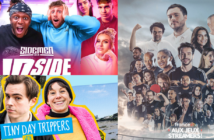When Netflix launched House of Cards in 2013, they already knew that its first original series would be a hit. The show was created based on data about the viewing habits of its back then 33 million users. Netflix knew how many of their users watch movies directed by David Fincher and starring Kevin Spacey. Also, using their tagging (inserted by viewers commissioned to describe the talent, the action, the tone and the genre, amongst other things) and recommendation systems they could tell how many users watch political dramas.
Jonathan Friedland, the company’s chief communications officer, said, “because we have a direct relationship with consumers, we know what people like to watch and that helps us understand how big the interest is going to be for a given show. It gave us some confidence that we could find an audience for a show like House of Cards. ” For the Netflix executives it was such a no-brainer that the company committed $100 million for two 13-episode seasons.
Detailed viewing habits are starting to become factors in the creation of original programming. Film and TV producers have always used data. Feedback from focus group test screenings and previews may lead to movie alterations. As a technology company that distributes and also produces original content, Netflix has incredible access to consumer sentiment and behaviour in real time. Netflix senior data scientist Mohammad Sabah said, “75 percent of users select movies based on the company’s recommendations.“ This way Netflix also saves substantially on marketing costs.
House of Cards was a pioneer in bridging the intersection of Big Data and entertainment. But will screenplays really be written some day to meet the wants of data-driven media companies? Could Big Data eventually drive a creative strategy?
Probably not. Netflix insists that actual creative decisions will remain in the hands of the creators. And as John Landgraf, the president and general manager of FX Networks said, “number-crunching would never have predicted the success of The Sopranos, South Park and Mad Men.”
The game has clearly changed, though, and Big Data does in fact contain the opportunity for even richer and more diverse programming. According to Big Data author Phil Simon, one study found that Netflix’s content data are derived from 77,000 different subgenres such as “Violent Suspenseful Action & Adventure from the 1980s” and “Romantic Indian Crime Dramas”. All these data help in matching very specific content to customers and at the same time in creating original content that appeals to a mass audience.
However, sometimes the numbers don’t add up. ABC’s Selfie, for example, had all the features that makes a successful TV show. It’s based on a popular musical, tailor-made for those who love social networking, and starred Karen Gillan who starredin Doctor Who. Phil Simon said, “it’s likely that ABC looked at its own data, Nielsen ratings and even third-party metadata to inform its choice of Selfie.” Yet, Selfie was cancelled halfway through its first season and subsequently moved to Hulu. This proves producers shouldn’t rely solely on data.
Personalised content recommendations are great, but sometimes we also like watching completely new and different content we would have never imagined to like or find interesting.
Tessa Sproule, the former director of digital at CBC, launched a new site called Vubble last year. Vubble is a combination of “video” and “bubble” and in contrast to sites like Facebook and Google, uses algorithms to generate short-form videos that run contrary to the users’ interests and preferences in order to get them out of their bubble. “The experience will be highly personalized. [Users] will get things that are in the bullseye of their interests, but occasionally we will toss things at them that are slightly outside their comfort zone”, said Sproule.
Big data and algorithms are here to stay and companies like Amazon, Facebook, Google, Twitter, Netflix, and Apple have already proven that Big Data can provide a huge competitive advantage. We just need to learn how to use them properly. Ted Sarandos, chief content officer of Netflix, recently suggested at Sundance Film Festival that in practice it’s probably a seventy-thirty mix. Seventy being the data and thirty is judgment. “But the thirty needs to be on top, if that makes sense.”
Sandra Lehner is senior social TV manager at joiz, and a frequent contributor to MIPBlog. Check out all of her posts here.
Image © Shutterstock / ra2studio




